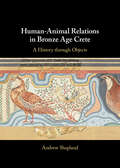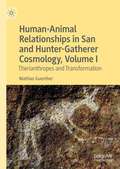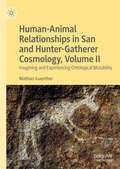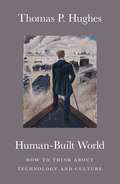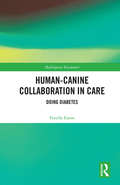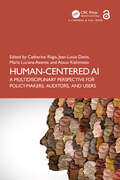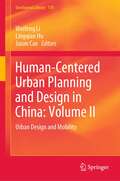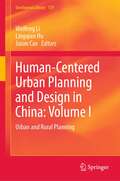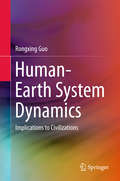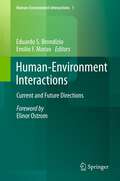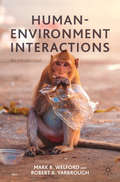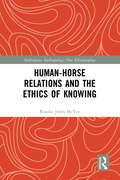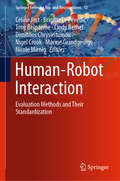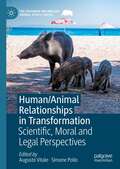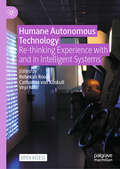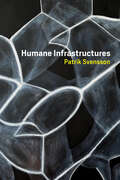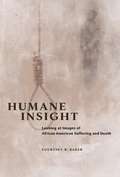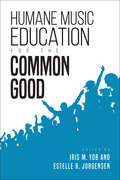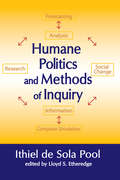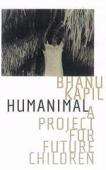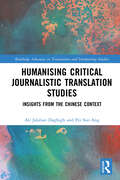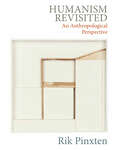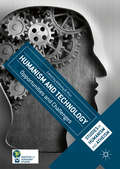- Table View
- List View
Human-Animal Relations in Bronze Age Crete Human-Animal Relations in Bronze Age Crete: A History through Objects
by Andrew ShaplandArchaeologists have long admired the naturalistic animal art of Minoan Crete, often explaining it in terms of religion or a love of the natural world. In this book, Andrew Shapland provides a new way of understanding animal depictions from Bronze Age Crete as the outcome of human-animal relations. Drawing on approaches from anthropology and Human-Animal Studies, he explores the stylistic development of animal depictions in different media, including frescoes, ceramics, stone vessels, seals and wall paintings, and explains them in terms of 'animal practices' such as bull-leaping, hunting, fishing and collecting. Integrating zooarchaeological finds, Shapland highlights the significance of objects and their associated human-animal relations in the history of the palaces, sanctuaries and tombs of Bronze Age Crete. His volume demonstrates how looking at animals opens up new perspectives on familiar sites such as Knossos and some of the most famous objects of this time and place.
Human-Animal Relationships in San and Hunter-Gatherer Cosmology, Volume I: Therianthropes and Transformation
by Mathias GuentherExploring a hitherto unexamined aspect of San cosmology, Mathias Guenther’s two volumes on human-animal relations in San cosmology link “new Animism” with Khoisan Studies, providing valuable insights for Khoisan Studies and San culture, but also for anthropological theory, relational ontology, folklorists, historians, literary critics and art historians. In Volume I, therianthropes and transformations, two manifestations of ontological mutability that are conceptually and phenomenologically linked, are contextualized in broader San myth. Guenther explores the pervasiveness of human-animal hybridity and transformation in San expressive culture (myth, stories and storytelling, ludic dancing and art, ancestral rock art and contemporary easel art), ritual (trance dance curing, female and male rites of passage) and hunting. Transformation is shown to be experienced by humans, particularly via rituals and dancing that evoke animal identity mergers, but also by hunters who may engage with their prey animals in terms of sympathy and inter-subjectivity, particularly through the use of “hunting medicines.”
Human-Animal Relationships in San and Hunter-Gatherer Cosmology, Volume II: Imagining and Experiencing Ontological Mutability
by Mathias GuentherExploring a hitherto unexamined aspect of San cosmology, Mathias Guenther’s two volumes on human-animal relations in San cosmology link “new Animism” with Khoisan Studies, providing valuable insights for Khoisan Studies and San culture, but also for anthropological theory, relational ontology, folklorists, historians, literary critics and art historians. Building from the examinations of San myth and contemporary culture in Volume I, Volume II considers the experiential implications of a cosmology in which ontological mutability—ambiguity and inconstancy—hold sway. As he considers how people experience ontological mutability and deal with profound identity issues mentally and affectively, Guenther explores three primary areas: general receptiveness to ontological ambiguity; the impact of the experience of transformation (both virtual/vicarious and actual/direct); and the intersection of the mythic, spirit world with reality. Through a comparative consideration of animistic cosmology amongst the San, Bantu-speakers and the Inuit of Canada’s eastern Arctic, alongside a discussion of animistic currents in Western humanities and ethology, Guenther clearly paints the relative strengths and weaknesses of New Animism discourse, particularly in relation to San ontology and cosmology, but with overarching relevance.
Human-Built World: How to Think about Technology and Culture
by Thomas P. HughesTo most people, technology has been reduced to computers, consumer goods, and military weapons; we speak of "technological progress" in terms of RAM and CD-ROMs and the flatness of our television screens. In Human-Built World, thankfully, Thomas Hughes restores to technology the conceptual richness and depth it deserves by chronicling the ideas about technology expressed by influential Western thinkers who not only understood its multifaceted character but who also explored its creative potential. Hughes draws on an enormous range of literature, art, and architecture to explore what technology has brought to society and culture, and to explain how we might begin to develop an "ecotechnology" that works with, not against, ecological systems. From the "Creator" model of development of the sixteenth century to the "big science" of the 1940s and 1950s to the architecture of Frank Gehry, Hughes nimbly charts the myriad ways that technology has been woven into the social and cultural fabric of different eras and the promises and problems it has offered. Thomas Jefferson, for instance, optimistically hoped that technology could be combined with nature to create an Edenic environment; Lewis Mumford, two centuries later, warned of the increasing mechanization of American life. Such divergent views, Hughes shows, have existed side by side, demonstrating the fundamental idea that "in its variety, technology is full of contradictions, laden with human folly, saved by occasional benign deeds, and rich with unintended consequences. " In Human-Built World, he offers the highly engaging history of these contradictions, follies, and consequences, a history that resurrects technology, rightfully, as more than gadgetry; it is in fact no less than an embodiment of human values.
Human-Canine Collaboration in Care: Doing Diabetes (Multispecies Encounters)
by Fenella EasonAdopting an anthrozoological perspective to study the participation of non-human animals in regimes of care, this book examines the use of canine scent detection to alert 'hypo-unaware' individuals to symptoms of human chronic illness. Based on ethnographic research and interviews, it focuses on the manner in which trained assistance dogs are able to use their sense of smell to alert human companions with Type 1 diabetes to imminent hypoglycaemic episodes, thus reducing the risk of collapse into unconsciousness, coma or, at worst, death. Through analyses of participant narrations of the everyday complexities of 'doing' diabetes with the assistance of medical alert dogs, the author sheds light on the way in which each human-canine dyad becomes acknowledged as a team of ‘one’ in society. Based on the concept of dogs as friends and work colleagues, as animate instruments and biomedical resources, the book raises conceptual questions surrounding the acceptable use of animals and their role within society. As such, this volume will appeal to scholars across the social sciences with interests in human-animal interactions and intersections. It may also appeal to healthcare practitioners and individuals interested in innovative multispecies methods of managing chronic illness.
Human-Centered AI: A Multidisciplinary Perspective for Policy-Makers, Auditors, and Users (Chapman & Hall/CRC Artificial Intelligence and Robotics Series)
by Jean-Louis Denis Catherine Régis Maria Luciana Axente Atsuo KishimotoArtificial intelligence (AI) permeates our lives in a growing number of ways. Relying solely on traditional, technology-driven approaches won't suffice to develop and deploy that technology in a way that truly enhances human experience. A new concept is desperately needed to reach that goal. That concept is Human-Centered AI (HCAI).With 29 captivating chapters, this book delves deep into the realm of HCAI. In Section I, it demystifies HCAI, exploring cutting-edge trends and approaches in its study, including the moral landscape of Large Language Models. Section II looks at how HCAI is viewed in different institutions—like the justice system, health system, and higher education—and how it could affect them. It examines how crafting HCAI could lead to better work. Section III offers practical insights and successful strategies to transform HCAI from theory to reality, for example, studying how using regulatory sandboxes could ensure the development of age-appropriate AI for kids. Finally, decision-makers and practitioners provide invaluable perspectives throughout the book, showcasing the real-world significance of its articles beyond academia.Authored by experts from a variety of backgrounds, sectors, disciplines, and countries, this engaging book offers a fascinating exploration of Human-Centered AI. Whether you're new to the subject or not, a decision-maker, a practitioner or simply an AI user, this book will help you gain a better understanding of HCAI's impact on our societies, and of why and how AI should really be developed and deployed in a human-centered future.
Human-Centered Urban Planning and Design in China: Urban Design and Mobility (GeoJournal Library #130)
by Jason Cao Weifeng Li Lingqian HuThis book provides insights and discusses human-centered urban design and placemaking, human activities and urban mobility in China. It argues that sustainable urban design and mobility should be “people-centered” and concerned about “place-making” in the new era of Chinese urbanization. Successful urban design and placemaking should adopt interdisciplinary approaches to planning and designing “space” and “place”. A core vision is the delivery of urban spaces that can cater to the needs of an increasingly diverse crowd of urban dwellers calling cities home. The book prompts Chinese urbanists to reconsider and explore a sustainable and people-first planning and design approach with Chinese characteristics. The breadth and depth of this book is of particular interest to those faculty members, students, practitioners and the general public who are interested in subjects like urban design, transport planning, mobility analysis and planning, housing and community development, infrastructure planning, environmental planning, social equity and beyond. This book discussing human-centered urban design and placemaking, human activities and urban mobility is part of a 2 volume set. Volume I deals with human-centered urban planning and development, rural planning and urban-rural coordination in China.
Human-Centered Urban Planning and Design in China: Urban and Rural Planning (GeoJournal Library #129)
by Jason Cao Weifeng Li Lingqian HuThis book explores a more human-centered development pathway associated with the ideological shift from "quantity" to "quality" growth in the new era of Chinese urbanization. Sustainable urban and rural planning should be “people-centered” and concerned about urban-rural coordination. The authors argue that successful urban and rural development in China should promote social equity, culture diversity, economic prosperity and sustainable built form. This book prompts Chinese urbanists to reconsider and explore a sustainable and people-first planning approach with Chinese characteristics. The breadth and depth of this book is of particular interest to the faculty members, students, practitioners and the general public who are interested in subjects like urban and regional planning, rural planning, housing and community development, infrastructure planning, climate change and ecological planning, environmental planning, social equity and beyond. This book dealing with human-centered urban planning and development, rural planning and urban-rural coordination in China is part of a 2 volume set. Volume II discusses human-centered urban design and placemaking, human activities and urban mobility.
Human-Earth System Dynamics: Implications To Civilizations
by Rongxing GuoThis book explores the factors and mechanisms that may have influenced the dynamic behaviors of earliest civilizations, focusing on both environmental (geographic) factors on which traditional historic analyses are based and human (behavioral) factors on which anthropological analyses are usually based. It also resurrects a number of common ancestral terms to help readers understand the complicated process of human and cultural evolution around the globe. Specifically, in almost all indigenous languages, the words ‘wa’ and any variants of it were originally associated with the sound of crying of – and certainly were selected as the common ancestral word with the meanings of “house, home, homeland, motherland, and so on” by – early humans living in different parts of the world.This book provides many neglected but still crucial environmental and biological clues about the rise and fall of civilizations – ones that have largely resulted from mankind’s long-lasting “Win-Stay Lose-Shift” games throughout the world. The narratives and findings presented at this book are unexpected but reasonable – and are what every student of anthropology or history needs to know and doesn't get in the usual text.“Professor Guo explores the dynamics of civilizations from the beginnings to our perplexingly complex world. There are lots of thought-provoking ideas here on the rise and decline of civilizations and nations... Anyone wishing to understand global developments should give this book serious consideration.” ----John Komlos, University of Munich, Germany, and Duke University, USA“It is interesting to see a Chinese perspective on the questions of deep history that have engaged Jared Diamond, Yuval Harari and David Christian. Guo argues that understanding cyclical threats has been the key to human progress, which is driven by the dialectic of material privation and human ingenuity.” ----Peter Rutland, Wesleyan University, USA
Human-Environment Interactions
by Emilio F. Moran Eduardo S. BrondízioDrawing on research from eleven countries across four continents, the 16 chapters in the volume bring perspectives from various specialties in anthropology and human ecology, institutional analysis, historical and political ecology, geography, archaeology, and land change sciences. The four sections of the volume reflect complementary approaches to HEI: health and adaptation approaches, land change and landscape management approaches, institutional and political-ecology approaches, and historical and archaeological approaches.
Human-Environment Interactions: An Introduction
by Mark R. Welford Robert A. YarbroughThis textbook explores the growing area of human-environment interaction. We live in the Anthropocene, an era dominated by humans, but also by the positive yet destructive environmental feedbacks that are poised to completely reset the relationships between nature and society. Modern and historic political, social, and cultural processes and physical landscape responses determine the intensity of these impacts. Yet different cultural groups, political and economic entities view, react to, and impact these human-environmental processes in spatially distinct and divergent ways. Providing an accessible, up-to-date, approach to human-environment interactions with balanced coverage of both social and natural science approaches to core environmental issues, this textbook is an integrative, multi-disciplinary offering that discusses environmental issues and processes within the context of human societies. The book begins by addressing the three most pressing issues of our time: climate change, threshold exceedance, and the 6th mass extinction. From there the authors identify within chapters on resources, population, agriculture and urbanization what precipitated and continues to sustain these three issues. They end with a chapter outlining some practical solutions to our human-environment crises.The book will be a valuable resource for interdisciplinary environment related courses bridging the gap between the social and natural sciences, human geographies and physical geographies.
Human-Environment Relations
by Emily Brady Pauline PhemisterThis fresh and innovative approach to human-environmental relations will revolutionise our understanding of the boundaries between ourselves and the environment we inhabit. The anthology is predicated on the notion that values shift back and forth between humans and the world around them in an ethical communicative zone called 'value-space'. The contributors examine the transformative interplay between external environments and human values, and identify concrete ways in which these norms, residing in and derived from self and society, are projected onto the environment.
Human-Horse Relations and the Ethics of Knowing (Multispecies Anthropology)
by Rosalie Jones McVeyThis book explores how equestrians are highly invested in the idea of profound connection between horse and human and focuses on the ethical problem of knowing horses. In describing how ‘true’ connection with horses matters, Rosalie Jones McVey investigates what sort of thing comes to count as a ‘good relationship’ and how riders work to get there. Drawing on fieldwork in the British horse world, she illuminates the ways in which equestrian culture instils the idea that horse people should know their horses better. Using horsemanship as one exemplary instance where ‘truth’ holds ethical traction, the book demonstrates the importance of epistemology in late modern ethical life. It also raises the question of whether, and how, the concept of truth should matter to multispecies ethnographers in their ethnographic representations of animals.
Human-Robot Interaction: Evaluation Methods and Their Standardization (Springer Series on Bio- and Neurosystems #12)
by Céline Jost Brigitte Le Pévédic Tony Belpaeme Cindy Bethel Dimitrios Chrysostomou Nigel Crook Marine Grandgeorge Nicole MirnigThis book offers the first comprehensive yet critical overview of methods used to evaluate interaction between humans and social robots. It reviews commonly used evaluation methods, and shows that they are not always suitable for this purpose. Using representative case studies, the book identifies good and bad practices for evaluating human-robot interactions and proposes new standardized processes as well as recommendations, carefully developed on the basis of intensive discussions between specialists in various HRI-related disciplines, e.g. psychology, ethology, ergonomics, sociology, ethnography, robotics, and computer science. The book is the result of a close, long-standing collaboration between the editors and the invited contributors, including, but not limited to, their inspiring discussions at the workshop on Evaluation Methods Standardization for Human-Robot Interaction (EMSHRI), which have been organized yearly since 2015. By highlighting and weighing good and bad practices in evaluation design for HRI, the book will stimulate the scientific community to search for better solutions, take advantages of interdisciplinary collaborations, and encourage the development of new standards to accommodate the growing presence of robots in the day-to-day and social lives of human beings.
Human-built World: How to Think About Technology and Culture
by Thomas HughesA Pulitzer Prize-nominated science writer draws on literature, art, and architecture to explore what technology has brought to society and culture, and to explain how technology can work with, not against, ecological concerns.
Human/Animal Relationships in Transformation: Scientific, Moral and Legal Perspectives (The Palgrave Macmillan Animal Ethics Series)
by Augusto Vitale Simone PolloThe ethics of human/animal relationships is a growing field of academic research and a topic for public discussion and regulatory interventions from law-makers, governments and private institutions. Human/animal relationships are in transformation and understanding the nature of this process is crucial for all those who believe that the enlargement of moral and legal recognition to nonhuman animals is part of contemporary moral and political progress. Understanding the nature of this process means analysing and critically discussing the philosophical, scientific and legal concepts and arguments embedded in it. This book contributes to the discussion by bringing together the ideas and reflections of leading experts from different disciplinary backgrounds and with a range of scientific perspectives.This book both provides an up-to-date examination of the transformation of human/animal relationships and presents ideas to foster this process.
Humane Autonomous Technology: Re-thinking Experience with and in Intelligent Systems
by Virpi Roto Rebekah Rousi Catharina Von KoskullThis open access book takes a human-focused multidisciplinary look at the ways in which autonomous technology shapes experience, affecting human lives and ways of working in settings ranging from the arts, design, and service to maritime and industry. The book focuses on the humane, observing how technology can be designed and implemented in an ethical, human-centered way. Chapters in this book highlight factors that impinge on the humane and ethical, such as challenging questions of intellectual property rights, roles of humans, biases, and the uptake of other deviant human traits. Through delving into a range of dimensions and contexts from culture, the arts and design, to service, heavy industry and maritime, the contributors demonstrate that artificial intelligence and its related autonomous systems need to be understood holistically, as a system of systems, that should be working for the benefit of human present and future.
Humane Infrastructures (metaLAB Projects)
by Patrik SvenssonHow we can work together to understand, imagine, and build humane infrastructures and a better world.Humane Infrastructures is a deep journey into humanistic and humane knowledge and how it can be engaged to help us collaboratively respond in ethical and sustainable ways to our current global challenges. Patrik Svensson takes the reader through a series of examples, case studies, experiments, and lively dialogues to reconsider infrastructure. He brings people, ideas, and perspectives in through a set of documents and documented experiences, some of which draw from the author&’s practice in Umeå, Stockholm, New York City, and Los Angeles. And he proposes frameworks, such as the idea of an infrastructure clinic, exploring them in staged dialogues and thought experiments.Imagining and building humane infrastructures require us to challenge the very nature of infrastructure, not necessarily all at once but rather step by step. The author consequently engages with infrastructure as a concept and frames it historically, critically, and creatively with research infrastructure as a central case study. He also considers integrative niches for humanities-related work, such as environmental humanities and disability studies, as sites for critical and constructive engagement with infrastructures, including the university itself. In the end, the exploration leads to a reimagination of the humanities and, more generally, higher education as part of a capacious public-facing effort of world-(re)building.The book will appeal to scholars in the humanities and a range of intersecting fields, such as infrastructure studies, critical computing, and design.
Humane Insight: Looking at Images of African American Suffering and Death
by Courtney R. BakerIn the history of black America, the image of the mortal, wounded, and dead black body has long been looked at by others from a safe distance. Courtney Baker questions the relationship between the spectator and victim and urges viewers to move beyond the safety of the "gaze" to cultivate a capacity for humane insight toward representations of human suffering. Utilizing the visual studies concept termed the "look," Baker interrogates how the notion of humanity was articulated and recognized in oft-referenced moments within the African American experience: the graphic brutality of the 1834 Lalaurie affair; the photographic exhibition of lynching, Without Sanctuary ; Emmett Till's murder and funeral; and the devastation caused by Hurricane Katrina. Contemplating these and other episodes, Baker traces how proponents of black freedom and dignity used the visual display of violence against the black body to galvanize action against racial injustice. An innovative cultural study that connects visual theory to African American history, Humane Insight asserts the importance of ethics in our analysis of race and visual culture, and reveals how representations of pain can become the currency of black liberation from injustice.
Humane Music Education for the Common Good (Counterpoints: Music and Education)
by Iris M. Yob and Estelle R. JorgensenWhy teach music? Who deserves a music education? Can making and learning about music serve the common good? A collection of essays considers the answers.In Humane Music Education for the Common Good, scholars and educators from around the world offer unique responses to the recent UNESCO report titled Rethinking Education: Toward the Common Good. This report suggests how, through purpose, policy, and pedagogy, education can and must respond to the challenges of our day in ways that respect and nurture all members of the human family.The contributors use this report as a framework to explore the implications and complexities that it raises. The book begins with analytical reflections on the report and then explores pedagogical case studies and practical models of music education that address social justice, inclusion, individual nurturance, and active involvement in the greater public welfare. The collection concludes by looking to the future, asking what more should be considered, and exploring how these ideals can be even more fully realized. This volume boldly expands the boundaries of the UNESCO report to reveal new ways to think about, be invested in, and use music education as a center for social change both today and going forward.
Humane Politics and Methods of Inquiry
by Ithiel de Sola PoolIthiel de Sola Pool was a distinguished scholar of the political process, and one of the most original thinkers in the development of an integrated social science. This volume focuses upon his contributions to the development of research methods that deepen our understanding of human behavior.The book is divided into five parts treating the analysis of communications, computer simulation, forecasting, network theory, and the social sciences in political contexts. The first part considers the problems and possibilities of analysis raised by the unprecedented quantity of data made available by widespread and improved communications technology; what should be counted and how should inferences be made. Part two explores computer simulation in the study of presidential election patterns and how it can provide in-depth analyses of crisis situations in history. Part three focuses on strategies for predicting the future of international politics and methods to forecast the impacts of new communications technologies, while part four offers a rigorous analysis of domestic and global contact networks and the so-called "small world" phenomenon.Part five is concerned with external challenges to the use of social science to create more humane politics, including the question of value neutrality, ideology, "deconstructive" critical theory, and threats by government to the health of universities. In a concluding essay Lloyd Etheredge draws upon Pool's work to discuss several new ways in which the methods treated in this volume can be applied to contemporary social change.
Humanimal: A Project for Future Children
by Bhanu KapilPoetry. Cross-Genre. Asian American Studies. In this new prose document, Bhanu Kapil follows a film crew to the Bengal jungle to re-encounter the true account of two girls found living with wolves in 1921. Taking as its source text the diary of the missionary who strove to rehabilitate these orphans—through language instruction and forcible correction of supinated limbs—HUMANIMAL functions as a healing mutation for three bodies and a companion poiesis for future physiologies. Through wolfgirls Kamala and Amala, there is a grafting: what scars down into the feral opens out also into the fierce, into a remembrance of Kapil's father. The humanimal text becomes one in which personal and postcolonial histories cross a wilderness to form supported metabiology. "Lucidly, holographically, your heart pulsed in the air next to your body; then my eyes clicked the photo into place. Future child, in the time you lived in, your arms always itched and flaked. To write this, the memoir of your body, I slip my arms into the sleeves of your shirt. I slip my arms into yours, to become four-limbed. "
Humanising Critical Journalistic Translation Studies: Insights from the Chinese Context (Routledge Advances in Translation and Interpreting Studies)
by Ali Jalalian Daghigh Pei Soo AngAli Jalalian Daghigh and Pei Soo Ang’s book provides new insights into the relationships between translation, journalism, ideology, and power via a humanising approach. Carving out a niche within Journalistic Translation Studies, the book introduces and expands on Critical Journalistic Translation Studies (CJTS). The authors critically evaluate the state of the art while advocating for humanising research by focusing on the experiences of both translators and readers.Using the Chinese journalistic translation landscape as a case study, the book investigates the socio-political and socio-cognitive dimensions of journalistic translation. Through applications of sociological, cognitive, and critical discourse approaches, it sheds light on the working conditions of news translators, their cognitive and emotional experiences, the influence of power and ideology on the translation process, the effects of ideological manipulation on translated news texts, and the subsequent impact of such news on audience perceptions and emotions.By opening fresh methodological pathways, not only does this book illuminate the Chinese journalistic translation landscape, but it also opens new avenues in CJTS. This book is an indispensable resource for academics, postgraduate students, and researchers in Translation Studies, Media Studies, and Journalism Studies, offering a transformative focus on humanising CJTS.
Humanism Revisited: An Anthropological Perspective
by Rik PinxtenThe West emancipated itself from the old humanism long ago and in doing so distanced itself from ‘heteronomy’: it declared that man, and not a non-human power, should be the first reference to approach people and nature. Today, as heirs of this tradition, we are still stuck in Eurocentrism (and often racism), and now even threaten to ruin nature by destroying biodiversity and causing the climate to warm up dangerously. Applied through an anthropological perspective, this book calls for a NEED-humanism: Not-Eurocentric, Ecological and (economically) Durable approach that can help promote inclusion and pluralism.
Humanism and Technology: Opportunities and Challenges (Studies in Humanism and Atheism)
by Anthony B. PinnThis book interrogates the ways in which new technological advances impact the thought and practices of humanism. Chapters investigate the social, political, and cultural implications of the creation and use of advanced forms of technology, examining both defining benefits and potential dangers. Contributors also discuss technology’s relationship to and impact on the shifting definitions we hold for humankind. International and multi-disciplinary in nature and scope, the volume presents an exploration of humanism and technology that is both racially diverse and gender sensitive. With great depth and self-awareness, contributors offer suggestions for how humanists and humanist organizations might think about and relate to technology in a rapidly changing world. More broadly, the book offers a critical humanistic interrogation of the concept of “progress” especially as it relates to technological advancement.
